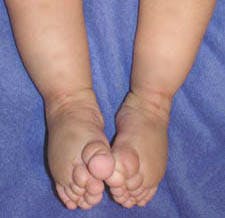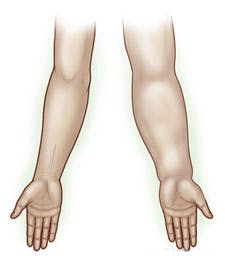Lymphedema is a relatively unknown condition for most people. The lymphatic system is part of the immune system and is really a “sewer system” for our bodies. If the lymphatic system is not working properly to rid the body of waste, one is more susceptible to infection or development of lymphedema which is an excess accumulation of fluid in the body (usually a limb). Lymphedema is commonly known as a complication of breast cancer but can be anywhere in the body.
Types of Lymphedema
There are 2 types of lymphedema: primary and secondary.
Primary Lymphedema….

Sometimes people develop primary lymphedema or have always had some problems with intermittent swelling in their legs typically referring to it as their “bad veins”. True primary lymphedema is a rare, inherited condition caused by problems with the development of lymph vessels in your body. Primary lymphedema can also have a late-onset – lymphedema tarda (a congenital disease characterized by underdevelopment of lymphatic pathways). It manifests commonly after the third decade as an accumulation of lymph in the interstitial spaces of the skin. Wound healing is significantly impaired.
Sometimes can be a combination of lymph problem and venous return problem – phlebolymphedma. Phlebolymphedema is the most common form of lymphedema in the Western world. It is a combined lymphatic and vascular condition that causes inflammation and lymphedema in the feet and lower legs.
Secondary Lymphedema….

![]()
Is caused by another health problem. It happens when a blockage or another problem changes the flow of lymph fluid through your body’s network of lymph vessels and nodes. Secondary lymphedema is typically the result of a surgery in which lymph vessels are removed. It is a common debilitating complication of breast cancer therapy/surgery and affects more than 1 in 5 breast cancer survivors. Patient-reported outcomes may be more important in predicting long-term health-related quality of life (HRQoL) than clinician-measured outcomes.
The key to treating lymphedema is early identification. Typically wearing compression garments, and regular completion of specific exercises can prevent or reverse swelling and help you keep it at bay in early stages. When this is not enough, manual lymphatic drainage (MLD) taught by a certified lymphedema therapist or physical therapist is the next step in managing lymphedema. Physical Therapists will teach specific manual technique interventions to stimulate the flow of lymphatic fluid which is then followed by wearing compression garments. MLD along with compression and exercise is one of the best ways people can manage their lymphedema.
Skincare for Lymphedema
A regular skincare routine is extremely important when living with lymphedema. Any injury or infection can make the swelling worse. This is because injury or infection can cause more damage to the lymphatic system in the area.
You can do a number of things to help protect your skin and lower your risk of infection or injury:
- Keep your skin clean and dry – cleanse daily using a soap substitute, such as aqueous cream, Oilatum or Neutrogena soap bars, or an E45 wash.
- Moisturize your skin at least once a day.
- Clean cuts or grazes straight away with clean water, then put antiseptic cream on and cover the area.
- Protect your skin from the sun by wearing a high factor sun cream or cover up with clothes.
- Use an insect repellent containing at least 50% DEET– if you’re bitten or stung, try not to scratch and use antihistamine cream.
- Avoid hot baths, saunas, and steam rooms because this can increase swelling.
- Avoid extremes of temperature that can dry your skin – including hot, cold, or windy weather.
- Don’t wear tight clothing or jewelry.
- Avoid sitting or standing for long periods of time if you have leg swelling.
- Don’t have injections, blood taken, or your blood pressure checked on the affected arm.
Any skin breaks can make you more likely to get an infection. Keeping your skin healthy, unbroken, and well moisturized helps to prevent this. There are different types of emollients, including bath oils, soap substitutes, and moisturizers. Avoid perfumed body lotions because they can dry your skin. You need to moisturize your skin every day. How you do this and what you use depends on the condition of your skin. Apply moisturizing cream with downward strokes. This way cream will not clog your hair follicles.
Remember, Knowledge is Power!
No matter the cause, lymphedema can be difficult to live with whether it is primary or secondary lymphedema, the key to lymphedema is early detection and getting the right treatment so it does not become a larger problem. MLD along with compression and exercise is one of the best ways people can manage their lymphedema. With regards to quality of life, the presence of metastasis and age are good predictors in how well a person can live with or control their lymphedema.
